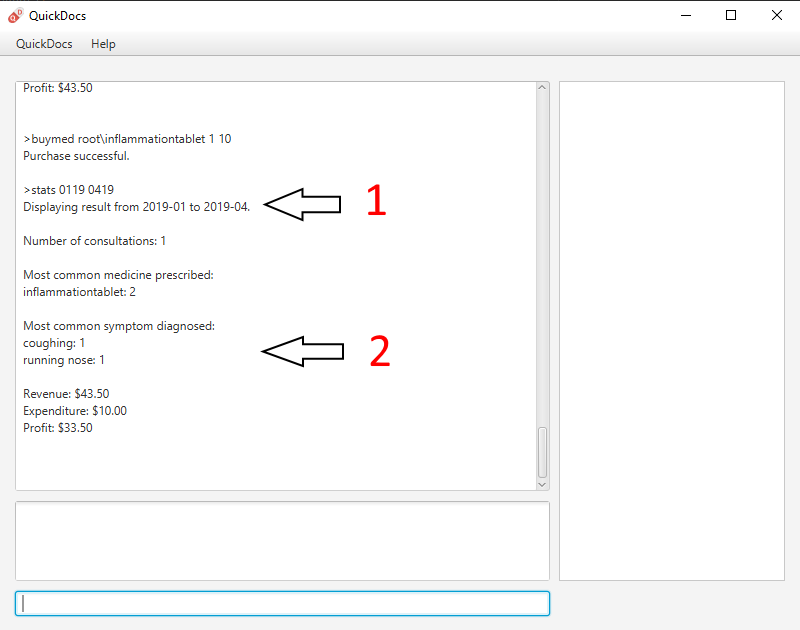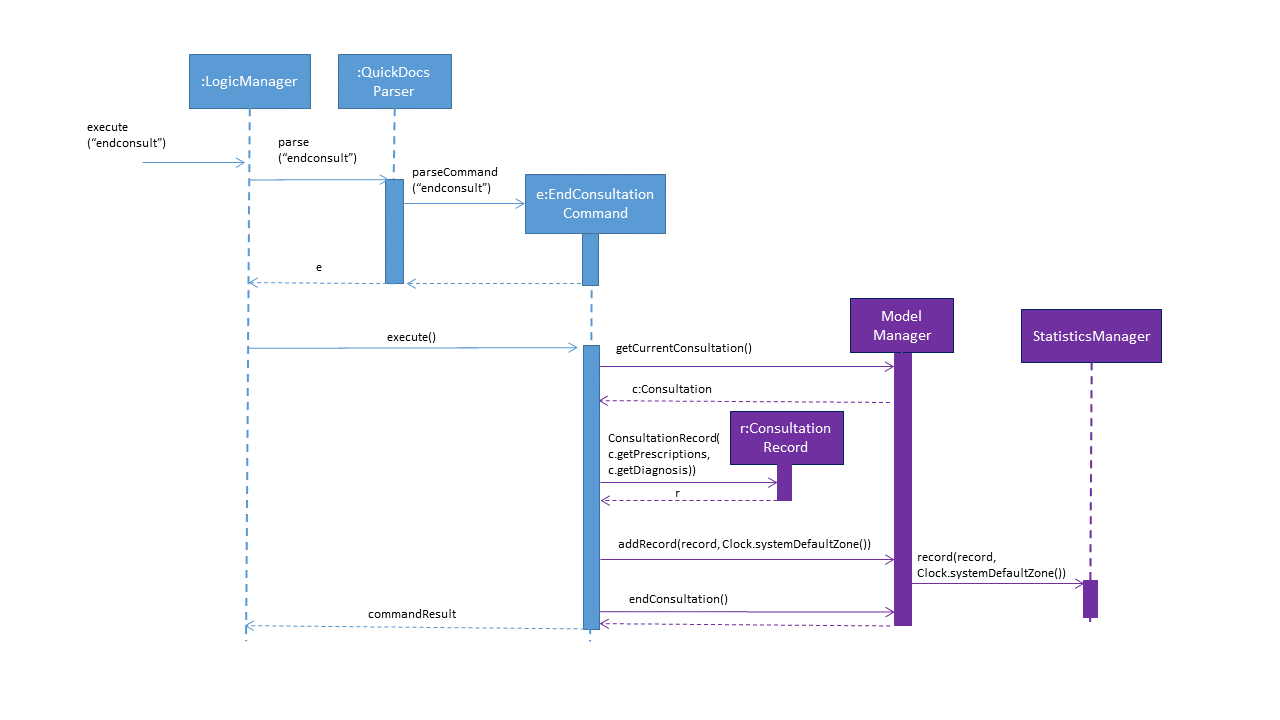Hello! Welcome to my project portfolio page (PPP). This PPP showcases the software development projects I have been involved so far. Currently, there is only 1 project listed — QuickDocs.
Introduction to QuickDocs
QuickDocs is an all-in-one software solution for private clinic doctors facing manpower issues. Private clinics are
usually small in size, with just a single doctor and 1 or 2 assistants. However, there are many tasks that the clinic
needs to handle, such as patient consultation and management, organising appointments, keeping track of the medicine
inventory and keeping track of finances.
Hence, my team and I have decided to morph an existing AddressBook application into a clinic management application, QuickDocs, that allows doctors to perform all the tasks above in a single application.
Summary of contributions
In this section, the summary of my contributions will be listed out. Contributions includes code, documentation, and other miscellaneous tasks that helped the team.
I was responsible for developing the calculation and storage of statistical information in QuickDocs, mainly financial and consultations information.
Major Enhancements:
-
Code Contributed: [Functional code]
-
Statistics command
-
What it does: Doctors can view statistics related to consultations and finances within a minimum time span of 1 month.
-
Why is it necessary:
-
By viewing the consultation statistics of the clinic, doctors can view the most common symptoms diagnosed and medicine prescribed. This allows them to look out for any possible trends in order to prepare for the future. The doctors could stock up on frequently prescribed medicines or prepare his clinic to be able to handle the most common illness in the past few months.
-
By viewing the financial statistics of the clinic, doctors can keep track of the revenue, expenditure, and profit of the clinic related to consultations and medicines. In addition, they could also use this as a cross-reference to their own accountings if desired.
-
-
Highlights: The statistics generated are done automatically whenever the doctor ends a consultation session on QuickDocs or adds purchased medicines to the QuickDocs medicine inventory. There is no need to manually save statistical information in QuickDocs. The doctor simply needs to enter the
statisticscommand with the date to retrieve the statistics.
-
Minor Enhancements:
-
Minor features developed
-
Developed command for setting the consultation fee in QuickDocs, which is required for accurate financial statistics generation.
-
-
Miscellaneous tasks
-
Team Collaboration:
-
Was involved in setting up Travis CI as the integration tool for our project.
-
Reviewed Pull Requests: [#129]
-
-
Documentation:
-
Helped to ensure consistent format for user guide.
-
Compiled the command summary section for user guide.
-
-
Contributions to the User Guide
The user guide is meant to aid users of QuickDocs if they encounter any issues. My additions to the user guide includes querying the statistics of the clinic, setting the consultaton fee, the FAQ, and the Command Summary. Shown below are the section for querying the statistics and setting the consultation fee. |
Setting consultation fee: setconsultfee
This command allows you to change your consultation fee in QuickDocs to what you charge for each consultation.
Setting up of your consultation fee is necessary for QuickDocs to generate accurate financial statistics pertaining
to your consultation sessions. Once your consultation fee is set, QuickDocs will remember it for you. Hence, you
only need to enter this command once, until you decide to change your consultation fee.
| The default consultation fee in QuickDocs in S$30.00. |
Format: setconsultfee AMOUNT
Alias : setfee
Examples:
-
setconsultfee 30
Sets the consultation fee to $30.00. -
setconsultfee $32.50
Sets the consultation fee to $32.50.
Viewing statistics: statistics
You are able to view the statistics of the clinic for a specific month, or between a range of months.
This command will show you 6 items in order:
-
Number of consultations
-
Most common medicines prescribed
-
Most common symptoms diagnosed
-
Revenue
-
Expenditure
-
Profit
|
In order for the calculated statistics pertaining to consultation finances to be accurate, you must have already
entered your clinic’s consultation fee beforehand. See: Set consultation fee. |
|
When there is a tie between the most commonly prescribed medicine, or most commonly diagnosed symptoms, all of them
will be listed. |
Format: statistics FROM_MMYYYY [TO_MMYYYY]
Alias : stats
If TO_MMYYYY is not specified, it will be defaulted to be equal to FROM_MMYYYY. |
Examples and Results:
-
statistics 012019
View the statistics for January 2019. -
stats 012019 042019
View the statistics from January 2019 to April 2019.
In the image below, the display area will return the statistics of the queried range of months.-
The result will show the range of months that were queried, followed by the 6 items mentioned earlier in order.
-
When there are more than one most common symptom diagnosed, QuickDocs will list them all out.
-

statistics 012019 042019Contributions to the Developer Guide
The developer guide is meant to be a starting point for any current or future developers that will be working on QuickDocs. My additions to the developer guide includes explaining the Logic component, and the implementation of the Statistics and Record feature. The implementation of the Statistics and Records feature will be shown below. |
Administrative and Statistics Module
The administrative and statistics module currently consists of 2 commands:
-
setting the consultation fee
setconsultfee -
querying the statistics
statistics
This 2 commands makes use of the classes located in filepath model\record.
Consultation fee
The consultation fee of the clinic is stored as a BigDecimal in the StatisticsManager of QuickDocs, which is loaded from the quickdocs.json file through the storage component. The consultation fee is used for calculating financial statistics for any ConsultationRecord objects.
Querying statistics
The statistics command is started through the command stats START_MMYYYY [END_MMYYYY].
The two MMYYYY corresponds to a range of dates. The end range is optional,
and is defaulted to the start range by the StatisticsCommandParser if it does not exist.
The start date is not allowed to be before January 2019, and the end date cannot be before the start date. Hence,
QuickDocs currently does not support adding old records before January 2019 due to the implementation of the
StatisticsManager. This will be explained in the section below.
|
MMYYYY is a string, e.g. "012019", which stands for January 2019. It is parsed by StatisticsCommandParser into a
YearMonth object. |
Statistics and Record - Current Implementation
The statistics class stores 6 types of information:
-
Number of consultations
-
Medicines prescribed
-
Symptoms diagnosed
-
Revenue
-
Expenditure
-
Profit
Number of consultations is stored as an int, while the financial variables are stored using BigDecimals. The number of
medicines prescribed and symptoms diagnosed are stored by using a HashMap.
| Implementation of additional statistics will be done through adding additional relevant variable fields. |
The implementation of Statistics and Record has 3 parts:
-
Creation of the Record
-
Adding the Record
-
Retrieving the Statistics
1. Creation of the Record
In order for the statistics to be keep tracked of, Record objects are used to retrieve information that the
StatisticsManager will make use of. The Record class is an abstract class that only has 1 abstract method,
toStatistics(StatisticsManager sm), which will generate a Statistics object.
Each child class of Record is for a specific operation in QuickDocs, where the implementation
toStatistics(StatisticsManager sm) will generate a Statistics object that stores relevant information pertaining to
that specific operation. The StatisticsManager is passed in to retrieve the any variable that the Record might require
to calculate the statistics, e.g., ConsultationRecord requires the consultationFee variable in StatisticsManager.
Currently, there are only 2 child classes of Record, ConsultationRecord and MedicinePurchaseRecord. ConsultationRecords
are created when the a consultation session ends from the EndConsultCommand, while MedicinePurchaseRecord are created
when a medicine is purchased via the PurchaseMedicineCommand. The commands will create the Record, and call ModelManager’s
addRecord(record, clock) function, which will then result in ModelManager calling StatisticsManager’s record(record, clock)
function. The clock used is the system clock, to retrieve the current YearMonth of the Record created. The sequence diagram
below illustrates an example ConsultationRecord being created.

2. Adding the record
The StatisticsManager holds an ArrayList of MonthStatistics, where a MonthStatistics object contains the YearMonth, and the Statistics object of that YearMonth. Each MonthStatistics object will be initialised with the zero Statistics object, where all the variables are 0 or contains no elements (not null). The ArrayList starts with a MonthStatistics with the YearMonth 2019 January, and every subsequent index will contain the MonthStatistics with the subsequent month, e.g., the 4th index contains the MonthStatistics with YearMonth 2019 May.
When the StatisticsManager adds a new Record by the record(record, clock) function, it will first retrieve the
YearMonth from the clock variable passed in. Next, it will update the size of the ArrayList by calling its own method
updateListSize(clock), which is a wrapper for updateListSize(YearMonth). Afterwards, StatisticsManager will find the
correct index of the MonthStatistics ArrayList to add the record in. In the current implementation, the record is not
actually stored. Instead, the record will be converted to a Statistics object which is then merged with the
MonthStatistics’s own Statistics object. The MonthStatistics’s Statistics object will then be reassigned with the newly
merged Statistics object. The sequence diagram below illustrates an example ConsultationRecord being added.

3. Retrieving the Statistics
When the StatisticsCommand queries for the statistics for a range
of months, Logic will call the ModelManager’s getStatistics(FROM_YEARMONTH, TO_YEARMONTH), which then calls
StatisticsManager’s getStatistics(FROM_YEARMONTH, TO_YEARMONTH). StatisticsManager will convert the YearMonth objects to
their respective indexes with the StatisticsManager’s getYearMonthIndex(YearMonth) function.
StatisticsManager will then obtain the statistics for each of the queried months, and merge them together into a new Statistics object. StatisticsManager will then return the Statistics back to the ModelManager, which would then return it to the StatisticsCommand, which would then return the CommandResult with the statistics converted to a String to the LogicManager.
Statistics and Record - Design considerations
-
The statistics are stored in months as the design only allows the doctor to query within a minimum timespan of 1 month. Hence, it was decided that the statistics to be stored in months in a chronological order with an ArrayList for ease of retrieval.
-
Currently, as QuickDOcs is developed in 2019, and there are no plans to allow the doctor to add in past records, the first index in the array of MonthStatistics is allocated to January 2019. Any MMYYYY value before 012019 will not be allowed.
-
The MonthStatistics objects are stored in an ArrayList as it might be desirable for a MonthStatistics with the zero statistics to exist (all variables 0 or no elements). Such a case might happen when the doctor goes on vacation for the whole month. In addition, it would be easy to retrieve the MonthStatistics object of a specific MMYYYY by indexing.
Statistics and Record - Alternatives Considered
The following table lists out the alternatives designs considered for implementing the storage of the Records and Statistics.
| Alternative | Description | Pros | Cons |
|---|---|---|---|
Storing of individual records for each month (Alternative chosen) |
Individual records are stored within the MonthStatistics, along with the Statistics. When the Statistics for a specific month is queried, update the latest statistics and return it. |
Individual records are kept, which could potentially be used for other calculations or features. |
Storing of individual records is extremely costly in terms of space |
Storing the merged statistics of all the records for each month |
When a new record is added, it is coverted to a Statistics object which is then merged with the current Statistics object stored. |
Only one Statistics object needs to be stored, which saves a lot of storage space. |
The individual records are unable to be retrieved. However, the current implementation has no need to retrieve individual records. |